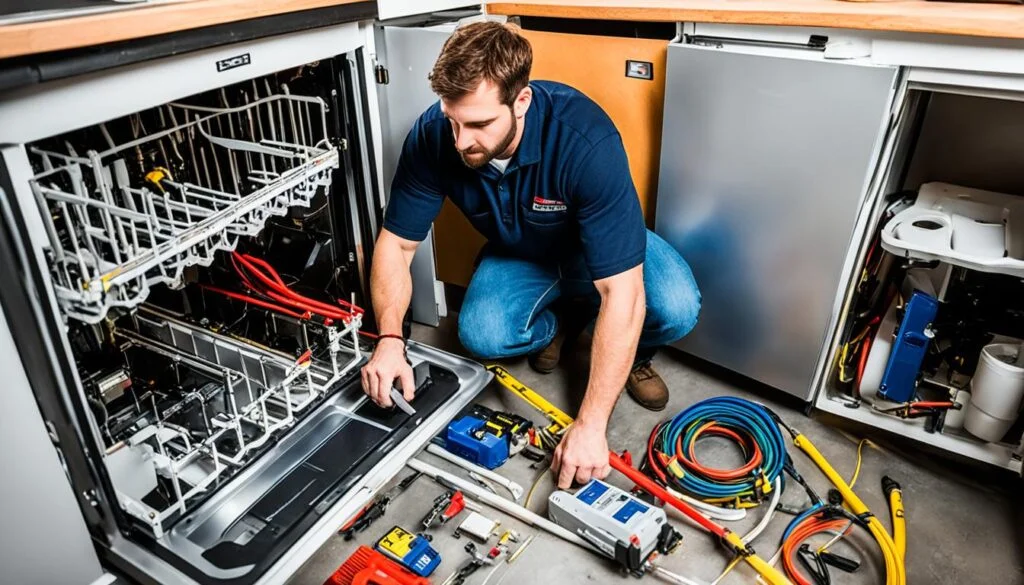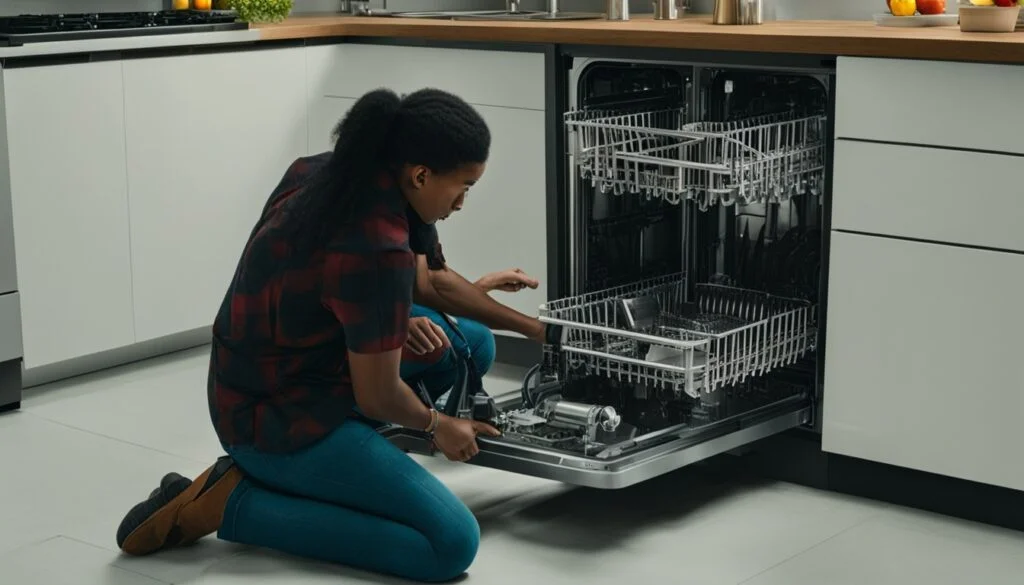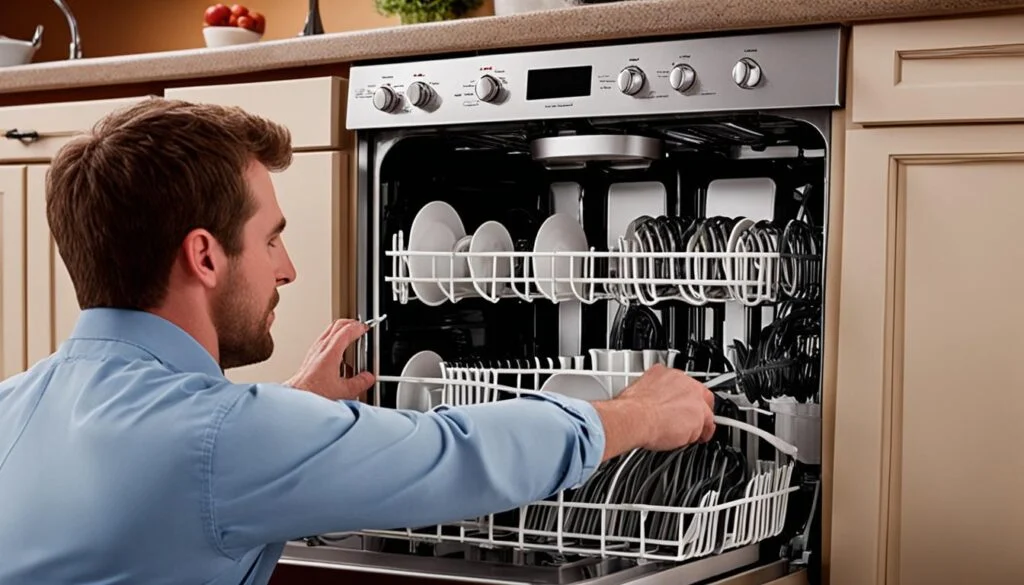Finding melted plastic on your dishwasher coil can be a distressing experience. The smell, the potential for damage, and the unsightly mess all contribute to a problem that requires immediate attention. Fortunately, with the right approach, you can remove the melted plastic safely and effectively. In this comprehensive guide, we will walk you through the step-by-step process to restore your dishwasher to its pristine condition.
Table of Contents
How to Get Melted Plastic Off Dishwasher Coil?
Removing melted plastic from a dishwasher coil can be a tricky task, but it’s manageable with the right approach. First, ensure that the dishwasher is completely unplugged to avoid any electrical hazards. Once it’s safe to work on, carefully inspect the area to determine how much plastic has melted onto the coil. If there are large pieces, use a plastic scraper or a wooden spatula to gently pry them off without scratching the metal surface.
For any remaining residue, you can try using heat to soften the plastic further. A hairdryer set on low heat can help; just be cautious not to overheat and damage the coil itself. After softening, use your scraper again to remove the residue. If needed, applying a small amount of rubbing alcohol or an adhesive remover on a cloth can help dissolve stubborn bits of plastic. Always remember to clean the area thoroughly afterward and allow it to dry before plugging the dishwasher back in and running it through a cycle.

Understanding the Problem: Why Does Plastic Melt on the Dishwasher Coil?
Before diving into the removal process, it’s essential to understand why this issue occurs. Dishwasher coils, typically located at the bottom of the appliance, are responsible for heating the water during the wash cycle. When plastic items, such as utensils or containers, accidentally fall onto the coil, the heat causes them to melt. The high temperatures in a dishwasher can easily reach the melting point of many common plastics, leading to a sticky and stubborn residue that adheres to the coil.
Step-by-Step Guide to Removing Melted Plastic from the Dishwasher Coil
1. Safety First: Turn Off the Power
Before attempting any cleaning or removal, it’s crucial to ensure your safety. Start by turning off the dishwasher and disconnecting it from the power source. This step will prevent any accidental electrical shock or injury while working on the appliance.
2. Allow the Coil to Cool Down Completely
Melted plastic on a hot coil can be extremely challenging to remove, and attempting to do so while the coil is still warm could cause burns or further damage. Allow the dishwasher to cool completely before proceeding with the removal process. This could take a couple of hours, depending on how recently the dishwasher was used.

3. Gather the Necessary Tools and Materials
To effectively remove the melted plastic, you’ll need the following tools and materials:
- A plastic scraper or spatula: This will help lift the melted plastic without scratching the coil.
- Ice packs or a bag of ice: Cooling the plastic further will make it easier to remove.
- A soft cloth or sponge: For cleaning the coil after removing the plastic.
- Baking soda and vinegar: These natural cleaning agents will help remove any remaining residue.
- Dish soap: For a final clean to ensure all traces of plastic and residue are gone.
4. Harden the Plastic for Easier Removal
To make the plastic easier to remove, you need to harden it first. Place ice packs or a bag of ice directly on the melted plastic. Leave it in place for about 15-20 minutes, or until the plastic becomes brittle. The cold will make the plastic less sticky and more likely to chip away cleanly.
5. Scrape Off the Hardened Plastic
Once the plastic has hardened, use the plastic scraper or spatula to carefully lift it off the coil. Start at the edges and work your way towards the center. Be gentle to avoid damaging the coil. If the plastic does not come off easily, you may need to reapply the ice and try again.
6. Use Baking Soda and Vinegar for Residual Cleaning
After removing the bulk of the plastic, there may still be some residue left on the coil. To clean this, create a paste by mixing baking soda with a small amount of water. Apply the paste to the affected area and let it sit for a few minutes. Then, dampen a cloth with vinegar and gently scrub the coil. The baking soda and vinegar will react, helping to lift any remaining plastic residue.

7. Final Clean with Dish Soap
For the final step, clean the coil with a soft cloth or sponge soaked in warm water and dish soap. This will remove any last traces of plastic and ensure the coil is clean and safe to use. Rinse the coil thoroughly with clean water and dry it completely before reconnecting the dishwasher to the power source.
8. Preventing Future Incidents
Now that your dishwasher is free of melted plastic, it’s wise to take steps to prevent this from happening again. Here are some tips:
- Check for Loose Items: Before running the dishwasher, check to ensure that all plastic items are secure and not likely to fall onto the coil.
- Avoid Placing Plastics Near the Coil: Place plastic items on the top rack or in a secure section of the bottom rack, away from the heating element.
- Use Dishwasher-Safe Plastics: Only use plastics that are labeled as dishwasher-safe, as they are more resistant to heat.
What to Do If the Plastic Won’t Come Off
In some cases, especially if the plastic has deeply adhered to the coil, the above methods may not be sufficient. If you find that the plastic won’t come off, you may need to consider professional help. A technician can safely remove the plastic without damaging the coil, ensuring that your dishwasher remains in good working condition.
The Importance of Regular Maintenance
Regular maintenance of your dishwasher is crucial to prevent issues like melted plastic on the coil. Clean your dishwasher regularly, checking for any debris that could fall onto the heating element. This simple step can prolong the life of your appliance and keep it running efficiently.
When to Replace the Dishwasher Coil
If, after multiple attempts, the plastic residue remains or the coil is damaged during the removal process, it might be time to replace the coil. Replacing a dishwasher coil is generally a straightforward process, but it’s important to ensure you’re using the correct part for your specific model. If you’re unsure, consult the manufacturer’s guide or contact a professional for assistance.
Conclusion
Dealing with melted plastic on your dishwasher coil can be a frustrating experience, but with the right approach, it’s a problem that can be resolved effectively. By following the steps outlined in this guide, you can safely remove the plastic, clean your coil, and prevent future incidents. Remember to prioritize safety throughout the process, and don’t hesitate to seek professional help if needed.

FAQs: Removing Melted Plastic from a Dishwasher Coil
Q1: Why did plastic melt on my dishwasher coil?
A: Plastic can melt on a dishwasher coil if it accidentally falls onto the coil during the wash cycle. The coil heats the water to high temperatures, which can cause plastic items to melt if they come into direct contact with it.
Q2: Is it safe to use my dishwasher if there’s melted plastic on the coil?
A: It’s not recommended to use your dishwasher until the melted plastic has been removed. Using the dishwasher with plastic on the coil could lead to unpleasant odors, potential damage to the coil, or even a fire hazard.
Q3: How long does it take for the dishwasher coil to cool down?
A: It can take a couple of hours for the dishwasher coil to cool down completely after a cycle. It’s important to ensure the coil is fully cooled before attempting to remove the plastic to avoid burns or further melting.
Q4: What tools do I need to remove melted plastic from the dishwasher coil?
A: You’ll need a plastic scraper or spatula, ice packs or a bag of ice, a soft cloth or sponge, baking soda, vinegar, and dish soap. These tools will help you safely and effectively remove the plastic and clean the coil.
Q5: Can I use metal tools to scrape off the plastic?
A: It’s best to avoid using metal tools as they can scratch or damage the coil. A plastic scraper or spatula is recommended for removing melted plastic.
Q6: What if the plastic won’t come off even after using ice?
A: If the plastic remains stubborn after using ice and a scraper, you may need to repeat the process or consider using a commercial cleaner designed for this purpose. If the problem persists, it’s advisable to contact a professional technician.
Q7: How can I prevent plastic from melting on the coil in the future?
A: To prevent future incidents, ensure that all plastic items are securely placed in the dishwasher, preferably on the top rack. Avoid placing plastics near the heating element, and only use dishwasher-safe plastics.
Q8: Can melted plastic damage my dishwasher coil?
A: If the melted plastic is not removed properly, it can potentially damage the coil by causing it to overheat or malfunction. It’s important to remove the plastic carefully to avoid causing any harm to the coil.
Q9: Should I replace the coil if it’s damaged by melted plastic?
A: If the coil is damaged during the removal process or the plastic cannot be completely removed, it may be necessary to replace the coil. Consult your dishwasher’s manufacturer guide or a professional for advice on replacement.
Q10: How often should I check my dishwasher for potential issues?
A: Regular maintenance is key to preventing problems. It’s a good idea to inspect your dishwasher for any loose items or debris before each wash cycle and clean the appliance regularly to ensure it operates smoothly.
These FAQs should help address common concerns and provide clear guidance on dealing with melted plastic in a dishwasher.

